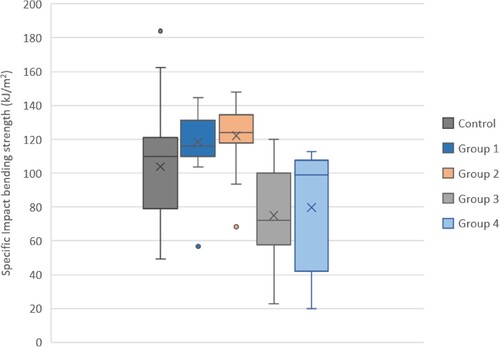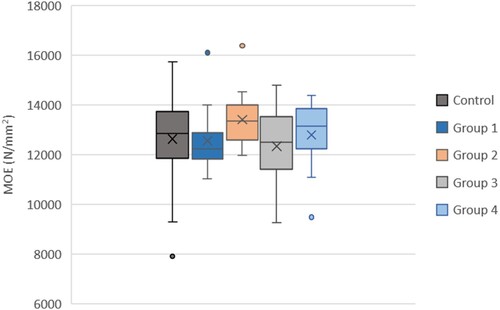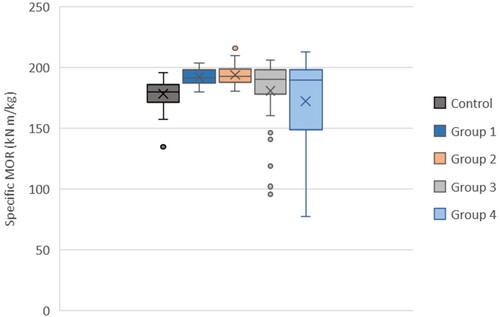 ?Mathematical formulae have been encoded as MathML and are displayed in this HTML version using MathJax in order to improve their display. Uncheck the box to turn MathJax off. This feature requires Javascript. Click on a formula to zoom.
?Mathematical formulae have been encoded as MathML and are displayed in this HTML version using MathJax in order to improve their display. Uncheck the box to turn MathJax off. This feature requires Javascript. Click on a formula to zoom.ABSTRACT
This study considered the mechanical properties of primary blue-stained sapwood of Norway spruce infested by the bark beetle Ips typographus. Nineteen stems from Stammerberg (ZH, Switzerland) were harvested in three different seasons and after different periods of bark beetle outbreaks. Density, Brinell hardness including elastic recovery after load, and key strength properties were tested on blue-stained wood and non-infected controls. Differences in mechanical properties were analysed according to the stand and storage time of the stems after the bark beetle attack. Spruce harvested at a late stage after the bark beetle attack (2–3 months) showed a clear reduction in impact bending strength, a significant loss in surface elastic recovery after indentation during Brinell hardness test, and a striking number of specimens with brittle fracture behaviour during Three-Point-Bending. Light microscopy and the results of the mechanical tests give clear evidence to suggest that wood-degrading fungi are already active in addition to the sap-staining fungi. Especially after larger outbreaks of bark beetles, it must be assumed that sapwood of Norway spruce does not only show the typical blue stain, but also incipient stages of wood degradation by wood-degrading fungi.
Introduction
The climatic conditions of recent years have weakened large parts of the Swiss forests. The spruce bark beetle (Ips typographus) in particular, was able to proliferate due to heat, wind throw, and drought and infested large parts of Norway spruce forests in Switzerland. Due to the mutual relationship of Ips typographus with various plant-pathogenic blue-staining fungi such as Ophiostoma polonicum (Furniss et al. Citation1990), these fungi get transmitted by beetles to new host trees. Large parts of the spruce sapwood are blue-stained soon after the invasion of the beetles and before the trees are harvested. This type of discoloration is called primary blue stain. However, the bark beetle Ips typographus does not only introduce blue staining fungi into the spruce trees but also yeast, mould fungi (Rennerfelt Citation1950), and a number of wood-decay fungi (Krokene and Solheim et al. Citation1996; Kirschner Citation2001; Persson et al. Citation2011).
Norway spruce and Scots pine with secondary blue stain or rather sap-stain, were extensively characterized and described in earlier studies between the years 1930 and 1940 (Findlay and Pettifor Citation1937; Jalava Citation1938; Chapman Citation1940). While Findlay concluded that the bending strength and stiffness of wood was not affected to any extent by the staining of the timber and Jalava could not see any impact on the mechanical properties, Chapman found a broad correlation between the abundance of direct cell wall penetration by the fungi and the reduction in toughness. Chapman stated that discoloration intensity was not indicative of the severity of attack nor of the comparative weakening of the wood caused by fungi. There are also some recent studies on the influence of secondary blue stain on the mechanical properties of different wood species, mainly Norway spruce and Scots pine, all with the same conclusion i.e. secondary sap stain does not influence the mechanical properties of wood (Glos and Gamm Citation1987; Schmidt Citation2006; Humar et al. Citation2008; Dimou et al. Citation2017).
Perhaps due to the long-standing findings that secondary sap stain does not alter the mechanical properties of wood, only a few studies have been conducted to evaluate the mechanical properties of bark beetle-infested primary blue-stained Norway spruce. Kržišnik (Kržišnik et al. Citation2018) concluded that the key mechanical properties (bending and compression strength) of primary blue-stained Norway spruce are almost unaffected and comparable to sound wood. Finally, Lum (Lum et al. Citation2006) summarised that blue stain did not have a negative effect on the mechanical properties of the bark beetle-infested Lodgepole pine. On the contrary, McLain (McLain et al. Citation1980) found that blue-stained Scots pine wood was weaker in toughness, flexure, and compression compared to healthy trees and the longer the time after foliage fall of infested trees, the greater the strength loss.
It is questionable, if the primary blue stain and the so-called secondary blue stain, i.e. the sap-stain of sawn timber are comparable with respect to their influence on the mechanical properties of wood. The existing literature as mentioned in the previous paragraph on mechanical properties of primary blue-stained softwood infested by bark beetles is contradictory and gives unique results that would permit definitive conclusions to be drawn. There is great uncertainty among some Swiss wood-processing companies about the risk-free use of primary blue-stained Norway spruce, especially after the wood market was flooded with timber, which originates from forests with devastating bark beetle outbreaks of the last years.
Therefore and to provide more evident data, a comprehensive study was conducted to investigate the practically relevant properties of primary blue-stained Norway spruce in Switzerland. This article presents the results pertaining to the characterization of the mechanical properties.
Materials and methods
Wood material and test specimens
Norway spruce (Picea abies) harvested at Stammerberg (ZH, Switzerland) was used for the study. The stems were collected in different seasons as described in .
Table 1. Overview of harvested trees.
Five healthy trees were harvested as reference material, referred to as control. Material of group No. 1 and 2 originate from the same trees and represents the properties of Norway spruce harvested shortly after bark beetle attack and processed immediately. While the lower part of the trunks showed no discoloration (group No. 1), the sapwood of the upper part of the trunks was already blue-stained (group No. 2). Material of group No. 3 represents the properties of blue-stained Norway spruce harvested 2–3 months after bark beetle attack and processed in the sawmill within one month. As representative material of large outbreaks, trees harvested 3 to 4 months after bark beetle attack and sawn to boards several weeks after harvesting were selected for group No. 4. The 20 boards showed red-streaking caused by the wood-degrading fungi (Stereum sanguinolentum) next to blue stain .
Figure 1. Cross-section of a Norway spruce (group No. 3) were the sapwood was completely blue-stained at the time of felling.
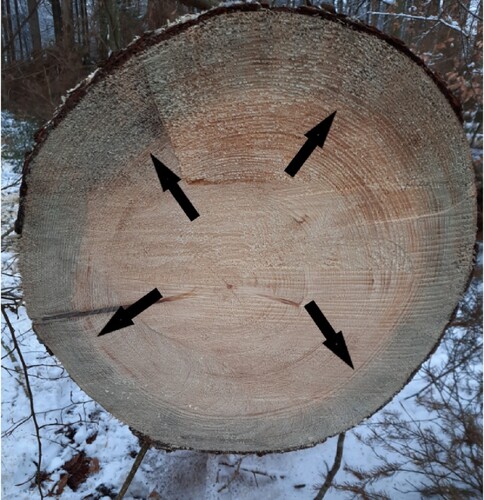
The 5 m long logs were sawn into 60 mm thick boards. All boards were dried in an industrial dry kiln chamber to reach a moisture content (MC) of 12%. No timber was treated with any sort of biocides before or after kiln drying. Exclusively sapwood was used for further sample preparation. The total numbers of specimen for the different tests are given in .
Table 2. The number of specimens used for testing the different material properties.
All samples to be tested were previously conditioned at constant mass in atmosphere with relative humidity of (65 ± 5) % and temperature of (20 ± 2) °C.
Light microscopy
A total of 20–30 µm thin transverse and longitudinal (radial and tangential) sections were cut from small wood blocks of group No. 1 and from a fractured specimen (3-P-bending) of group No. 3 and 4 with a sledge microtome. The sections were stained with 2% aqueous Astra blue followed by 2% aqueous safranin solutions. Hyphae of blue stain fungi (Ascomycetes) are pigmented dark brown while non-lignified parts such as hyphae of wood-decaying fungi (Basidiomycetes) turned blue. Lignified parts of the wood appeared red.
Density
The density was determined in accordance with DIN 52182 standard ‘Testing of wood; determination of density’ (DIN 52182, Citation1976-Citation09).
Three-point-bending test
Statistic three-point-bending (3-P-bending) tests were conducted according to DIN 52186 standard ‘Testing of wood; bending test’ (DIN 52186, Citation1978-Citation06). Samples with dimensions of 360 × 20 × 20 mm (longitudinal × tangential × radial) were tested on a ZwickRoell Z100 universal testing machine with a 100 kN load cell, a span of 300 mm, a testing speed of 6 mm/min and a preload of 5 N. The mean values of the modulus of elasticity (MOE) and the modulus of rupture (MOR) in bending were determined.
Impact bending test
Impact bending strength (IBS) was determined according to DIN 52189 standard ‘Testing of wood; determination of impact bending strength’ (DIN 52189, Citation1981-Citation12). Samples with dimensions of 300 × 20 × 20 mm (longitudinal × tangential × radial) were tested on a Wolpert pendulum impact tester with a 150 J pendulum and a span of 240 mm.
Compression test
The compression strength parallel to the grain was determined according to DIN 52185 standard ‘Testing of wood; compression test parallel to grain’ (DIN 52185, Citation1976-Citation09). Samples with dimensions 40 × 20 × 20 mm (longitudinal × tangential × radial) were tested on a ZwickRoell Z100 with a 100 kN load cell, using a testing speed of 6 mm/min and a preload of 5 N. The mean values of the modulus of elasticity (MOE) and modulus of rupture (MOR) in compression parallel to the grain were determined.
Shear test
The shear strength parallel to the grain was determined according to DIN 52187 standard ‘Testing of wood; determination of ultimate shearing stress parallel to grain’ (DIN 52187, Citation1979-Citation05). Samples with dimensions 45 × 50 × 50 mm (longitudinal × tangential × radial) were tested on a ZwickRoell Z100 with a 100 kN load cell, a testing speed in tangential direction of 1,2 mm/min and in radial direction of 2,8 mm/min and a preload of 100 N were used. The mean values of the shear strength longitudinal/tangential (τLT) and longitudinal/radial (τLR) were calculated.
Brinell hardness and surface elastic recovery
The resistance to indentation was determined according to DIN EN 1534 standard ‘Wood flooring – Determination of resistance to indentation’ (DIN EN 1534:2011-01, Citation2011). Samples with dimensions 50 × 50 × 50 mm (longitudinal × tangential × radial) were tested on a ZwickRoell Z100 with a hardness measuring device with a 2,5 kN load cell (WN256112) and a preload of 1 N. The measurement depth of the indentation was used for the calculation of the Brinell hardness (HB) as described in (Laine et al. Citation2016). The mean values of the Brinell hardness of the radial (HBR) and tangential (HBT) sections and the associated surface elastic recovery (SE) after load were calculated.
Specific material properties
The specific moduli (MOEspecific and MORspecific), the specific strength (IBSspecific and τspecific) and the specific Brinell hardness (HBspecific), consisting of the corresponding value per mass density of the sample, were calculated. Thus, the influence of the natural density variability of the wood is excluded and therefore a better comparability of the different sample groups was possible.
Statistical hypothesis test
A statistical hypothesis test (two sample t-test) with a significance level of 0.05 was performed in ‘Origin 2021b’, to decide whether the data-sets of the blue-stained sample are different from the control. The calculated p-values are given in the Supplementary information (Table A1).
To understand the strength of the difference between the two groups (control vs. experimental) Cohen’s d as an appropriate effect size was calculated according to Equations (1) and (2):
(1)
(1)
(2)
(2) d effect size
M mean of the experimental group
SD standard deviation
n group size
Cohen (Cohen Citation1992) suggested that d > 0.2 be considered a ‘small’, d > 0.5 represents a ‘medium’ and d > 0.8 a ‘large’ effect size. An effect size less than 0.2 indicates a negligible difference, even if it is statistically significant. The mechanical test findings are discussed regarding significant differences and the corresponding effect size.
Results and discussion
Microscopy
Microscopic examinations of the tracheids of the bark beetle-infested spruce sapwood (sample group No. 1 to 4) confirmed that wood-degrading basidiomycetes (e.g. Stereum species) were already active alongside the blue-staining ascomycetes (e.g. Aureobasidium, Sclerophoma, and Ophiostoma species). Hyphae of basidiomycetes were even found in the sapwood of group No. 1, which did not show any blue-staining at that time. ().
Figure 2. Hyphae of blue-staining fungi (orange arrow) and wood-degrading fungi (blue arrows) in tracheids of bark beetle infested spruce sapwood.
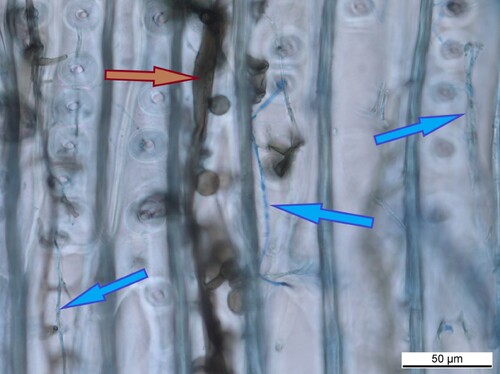
Favourable growth conditions in the stems as well as a sufficiently long standing and storage time of the infested trees can facilitate a degradation of cell wall substances by Stereum species and others.
Density
The density of all tested sample sets () agreed well with the density of Norway spruce (430–470 kg/m3) as given in the literature (Sell Citation1989). Although density values of group No. 3 (440 ± 29.7 kg/m3) and group No. 4 (435 ± 20.6 kg/m3) were still in the natural range of Norway spruce, the mean values of these groups were significantly lower than the mean of the control (467 ± 28.9 kg/m3).
A considerably decreased wood density caused exclusively by blue-staining fungi seems unlikely (Rouco and Muñoz Citation2015). Even if isolates of tested Ascomycetes (Ophiostoma spp., Sphaeropsis sapinea) contain low amounts of cell wall degrading enzymes such as xylanase and pectinase (Schirp et al. Citation2003), sap staining fungi preferentially metabolize readily accessible non-structural wood components, such as starch, sugars, proteins, and extractives as the main nutrient source. The sap-staining fungi but, above all, the activity of wood-degrading fungi might be a possible explanation for the small but non-negligible density reduction of the tested Norway spruce, especially specimens of group No. 4. Nevertheless, it cannot be completely ruled out that the differences in density are only the result of natural variability.
Strength properties
The mean impact bending strength of the control (49 kJ/m2) is comparable to the typical value (40–50 kJ/m2) as described in the literature (Sell Citation1989). The majority of specimens from group No. 3 (−36% on average) and No. 4 (−33% on average) showed an impact bending strength below the mean value of the control. The same trend applied to the specific impact bending strength, which excluded the influence of the natural density variability ().
Approximately 50% of the specimens from group No. 3 and No. 4 failed with a brittle fracture pattern as is characteristic for fungi-degraded wood. In contrast, more than 96% of all specimens out of the control batch and group No. 1 and 2 showed a fibrous, very jagged, and irregular fracture pattern as is characteristic of naturally unaffected wood. shows examples of fracture patterns after an impact bending test.
Figure 5. Examples of fractured surfaces after impact bending: fibrous, non-brittle (green coloured frame) and brittle (red coloured frame) in the tensile zone.
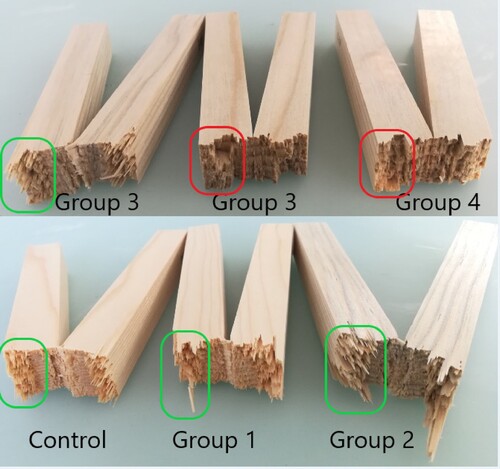
Mean values of the modulus of elasticity (MOE) in 3-P-bending for all tested groups were not significantly different compared to the control ().
The values of the modulus of rupture (MOR) were comparable as well when looking at the mean values. Nevertheless, samples of group No. 4 showed a trend to lower MOR data values when compared to the other batches ().
A closer examination of the individual 3-P-bending test protocols (force-deflection-graph) as exemplified in ) and a visual assessment of the associated fractured surfaces () showed clear differences between the tested sample groups.
Figure 8. Force-deflection graph; representative example of a ductile (non-brittle) and a brittle fracture behaviour of blue-stained specimen of group No. 3.
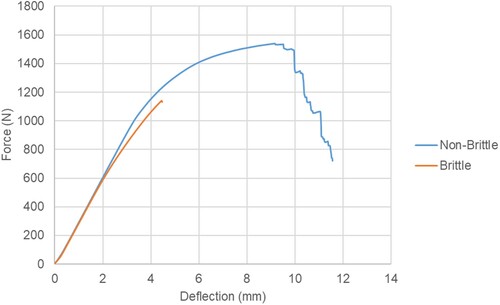
Figure 9. Fracture pattern of blue-stained samples after 3-P-Bending; a) fibrous fracture pattern in the tensile zone, b) plane fracture pattern across the entire fractured surface.

All specimens from the control and group No. 1 and 2 showed a non-brittle fracture behaviour with a fibrous fracture pattern in the tensile zone ( a) after 3-P-bending. Specimens from longer-infested and stored spruce trees (group No. 3 and 4) failed partially in a brittle manner, with plane-fractured surfaces ( b). Approximately 18% of the specimens group No. 3 and 40% of the specimens group No. 4 showed this brittle fracture behaviour. These evaluations show that even if the mean values for MOE and MOR in 3-P-bending are inconspicuous, some samples already exhibited an unusual brittle fracture behaviour as already observed in the impact-bending test.
The ultimate shear strength as well as the compression strength of all tested sample groups were not significantly lower than the control (see ) and in the typical range of spruce as given by Sell (Sell Citation1989). The marginal differences between the test groups corresponded to the different densities of the tested specimens and the natural variability of wood.
Table 3. Mechanical properties of Norway spruce determined at a MC of 12%. Grey shaded cells indicate significantly lower values to the control. Statistical data are given in the Supplementary information Table A1.
Brinell hardness
There was no clear difference between the specific Brinell hardness (HBT Specific) tested on tangential surfaces. The specific Brinell hardness tested on radial surfaces (HBR Specific) of specimen group No. 4 was lower on average compared to the control. The specific Brinell hardness of the specimens varied greatly, however, this is expected and depends on the tested area, i.e. if the test is conducted on early or latewood. Differences between all sample groups were more evident in the surface elastic recovery after load (SE), especially on tangential surfaces. While the surface elasticity of sample group No. 3 decreased by 21% (tangential) and by 12% (radial) on average compared to the control, sample group No. 4 exhibited even higher differences with 25% (tangential) and 19% (radial) lower surface elasticity on average compared to the control ().
A decrease in elastic recovery potential simultaneously means an increase in damping behaviour, which is an indicator of changes in the wood structure, as in the case of fungal decay (Bariska et al. Citation1983).
Summary
Results of this study show that some mechanical properties of Norway spruce wood infested by the bark beetle Ips typographus and with obvious primary blue stain (grey shaded cells in ) may differ significantly from the timber of unaffected trees. presents an overview of all the test results. Additionally, Table A1 in the Supplementary information section presents the corresponding data sets of the statistical evaluation.
Immediately after the bark beetle outbreak, harvested and processed Norway spruce wood showed no loss in any of the tested mechanical properties. In contrast, the blue-stained sapwood of Norway spruce harvested 2–3 months after the bark beetle attack showed a minor but measurable decrease in density, a clear loss of impact bending strength, a significant loss in surface elastic recovery after load, and a striking number of specimens with brittle fracture behaviour in 3-P-bending.
The loss of wood elasticity, which is reflected in a reduced elastic recovery behavior of the surface and in a decreased impact strength, is the first sign of the depolymerization of cell wall components. An initial weakening of the wood substance as well as an incipient loss of elasticity, which was obvious in impact bending strength, bending strength, and surface elastic recovery after load, indicates an additional infestation of wood-destroying fungi on the blue-stained wood. The results are in line with the findings of Brischke and Welzbacher (Brischke et al. Citation2008), who proved that minor changes in the structural integrity of wood by fungal decay (basidiomycetes) are already detectable with mechanical tests, even before a measurable mass loss and before any wood substance have been metabolized. Glos and his team (Glos et al. Citation1987) also stated that an infestation of wood-destroying fungi results in decreased mechanical properties, already before a significant mass loss occurs.
Results for the blue-stained specimens cut from stems with longer stand and storage times after bark beetle attack (samples of group No. 3 and No. 4) are comparable to findings on fungi-degraded wood, where the greatest loss in mechanical properties occurs in impact bending strength and further in the sequence of bending strength, compressive strength, and hardness (Wazny Citation1958).
Many studies dealing with the influence of blue-staining fungi on the mechanical properties of wood such as (Humar et al. Citation2008), used artificially infected wood for their experiments. Therefore, the results only reflect the influence of the selected blue-staining fungi on the properties of the wood, but not necessarily the properties and behaviour of bark beetle Ips typographus infested timber, which mainly contains wood staining but also wood-degrading fungi. Depending on the stand and storage time of the stems after the bark beetle attack as well as the fungi growing conditions, such as the wood moisture content and temperature, it is very likely that simultaneous with blue-staining fungi, wood-degrading fungi also colonize the wood. Therefore, the longer the storage times until kiln drying of the infested wood, the greater the risk for loss of mechanical performance. This conclusion is in line with McLain's and Ifju's (McLain et al. Citation1980) findings for Southern pine, that the longer the time after foliage fade of the infested trees, the greater the strength loss.
Conclusion
The mechanical strength and the elasticity of blue-stained Norway spruce infected by the bark beetle Ips typographus can be reduced due to a simultaneous infestation by wood-degrading fungi.
Since the impact bending strength is significantly decreased, beetle-infested Norway spruce should not be used for applications in which this property is highly required (e.g. railing or scaffolding boards).
Further investigations such as the influence of moisture and humidity on the behaviour of the blue-stained Norway spruce, the applicability of coatings and their performance during natural weathering, as well as the resistance against further infestation with wood-destroying fungi are ongoing and will be presented in separate publications in the near future.
Conflict of interest
The authors declare that they have no known competing financial interests or personal relationships that could have appeared to influence the work reported in this paper.
Supplemental Material
Download MS Word (29.9 KB)Acknowledgements
The Forest and Wood Research Founding Switzerland (FOWO-CH), the Swiss Conference on Forests, Wildlife and Landscape (KWL), and Empa financially supported this work. We thank the Forest District Stammheim and the Sawmill Konrad Keller AG in Switzerland for providing and processing the wood. We also thank the following Associations of Swiss forest and wood industry for their content-related support: Holzindustrie Schweiz, VSH, and Wald Schweiz.
Disclosure statement
No potential conflict of interest was reported by the authors.
References
- Bariska, M., Osuský, A. and Bosshard, H. H. (1983) Änderung der Mechanischen Eigenschaften von Holz nach Abbau durch Basidiomyceten. Holz als Roh- und Werkstoff, 41(6), 241–245. DOI: 10.1007/BF02608570
- Brischke, C., Welzbacher, C. R. and Huckfeldt, T. (2008) Influence of fungal decay by different basidiomycetes on the structural integrity of Norway spruce wood. Holz als Roh- und Werkstoff, 66(6), 433–438. DOI: 10.1007/s00107-008-0257-1
- Chapman, A. D. (1940) Effect of blue stain on specific gravity and strength of southern pine. Journal of Agricultural Research, 61, 125–134.
- Cohen, J. (1992) A power primer. Psychological Bulletin, 112(1), 155–159.
- Dimou, V., Kaziolas, D. N., Zygomalas, I. and Avtzis, N. (2017) Influence of biotic factors on the mechanical properties of wood, taking into account the time of harvesting. Wood Material Science & Engineering, 12(3), 140–148. DOI: 10.1080/17480272.2015.1063004
- Findlay, W. and Pettifor, C. (1937) The effect of sap-stain on the properties of timber: I. effect of Sap-stain on the strength of Scots pine sapwood. Forestry: An International Journal of Forest Research, 11(1), 40–52.
- Furniss, M. M., Solheim, H. and Christiansen, E. (1990) Transmission of blue-stain fungi by Ips typographus (Coleoptera: Scolytidae) in Norway spruce. Annals of the Entomological Society of America, 83(4), 712–716. DOI: 10.1093/aesa/83.4.712
- Glos, P. and Gamm, A. (1987) Untersuchung der Festigkeit von Fichten-Bauholz nach Schädlingsbefall infolge von Waldschäden, DGfH Abschlussbericht 85502, Fraunhofer IRB Verlag.
- Humar, M., Vek, V. and Bučar, B. (2008) Properties of blue-stained wood. Svojstva Drva Zaraženoga Gljivama Plavila, 59(2), 75–79.
- Jalava, M. (1938) Effect of blue stain on the strength of pine timber. Helsinki, Teknillisiä Tiedonantoja (Finland Found. for Forest Prod. Res.), 8, 24.
- Kirschner, R. (2001) Diversity of filamentous fungi in bark beetle galleries in central Europe. In: J. K. Misra, ed, Trichomycetes and other fungal groups. CRC Press, 175–193.
- Krokene, P. and Solheim, H. (1996) Fungal associates of five bark beetle species colonizing Norway spruce. Canadian Journal of Forest Research, 26(12), 2115–2122. DOI: 10.1139/x26-240
- Kržišnik, D., Lesar, B., Thaler, N. and Humar, M. (2018) Performance of bark beetle damaged Norway spruce wood against water and fungal decay. bioresources.com, 13(2), 3473–3486.
- Laine, K., Segerholm, K., Wålinder, M., Rautkari, L. and Hughes, M. (2016) Wood densification and thermal modification: hardness, set-recovery and micromorphology. Wood Science and Technology, 50(5), 883–894.
- Lum, C., Byrne, T. and Casilla, R. (2006) Mechanical properties of lodgepole pine containing beetle-transmitted blue stain. Forest Products Journal, 56(6), 45–50.
- McLain, T. E. and Ifju, G. (1980) Strength properties of blue-stained wood from beetle-killed southern pine timber, Report, Virgina Polytechnic Inst. and State University Blacksburg.
- Persson, Y., Ihrmark, K. and Stenlid, J. (2011) Do bark beetles facilitate the establishment of rot fungi in Norway spruce? Fungal Ecology, 4(4), 262–269. https://doi.org/10.1016/j.funeco.2011.01.005
- Rennerfelt, E. (1950) Über den Zusammenhang Zwischen dem Verblauen des Holzes und den Insekten. Oikos, 2(1), 120–137. DOI: 10.2307/3564666
- Rouco, M. C. A. and Muñoz, G. R. (2015) Influence of blue stain on density and dimensional stability of Pinus radiata timber from northern Galicia (Spain). Holzforschung, 69(1), 97–102. doi:10.1515/hf-2014-0014
- Schirp, A., Farrell, R. L., Kreber, B. and Singh, A. P. (2003) Advances in understanding the ability of sapstaining fungi to produce cell wall-degrading enzymes. Wood and Fiber Science, 35(3), 434–444.
- Schmidt, O. (2006) Wood and tree fungi - Biology, Damage, Protection, and Use (Berlin: Springer Verlag).
- Sell, J. (1989) Eigenschaften und Kenngrössen von Holzarten, Baufachverlag Zürich.
- Wazny, J. (1958) Studien über die Einwirkungen von Merulius lacrymans Wulf. Fr. und Coniophora cerebella Pers. auf die mechanischen Eigenschaften befallenen Holzes. Holz als Roh- und Werkstoff, 16(5), 285–288.
- Standards of German Institute for Standardization (DIN e.V.)
- DIN 52182:1976-09 (1976) Testing of wood; determination of density.
- DIN 52186:1978-06 (1978) Testing of wood; bending test.
- DIN 52189:1981-12 (1981) Testing of wood; determination of impact bending strength.
- DIN 52185:1976-09 (1976) Testing of wood; compression test parallel to grain.
- DIN 52187:1979-05 (1979) Testing of wood; determination of ultimate shearing stress parallel to grain.
- DIN EN 1534:2011-01 (2011) Wood flooring – Determination of resistance to indentation.


